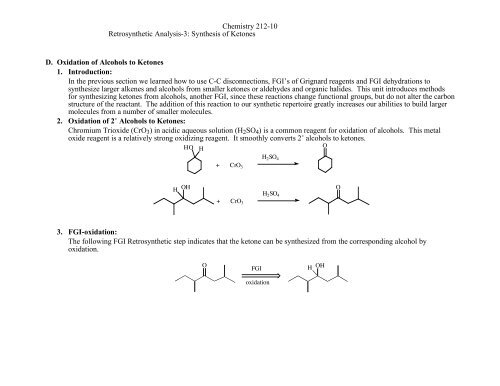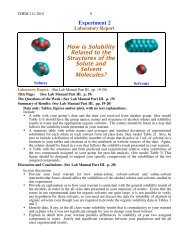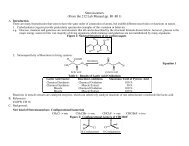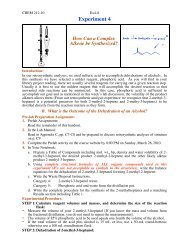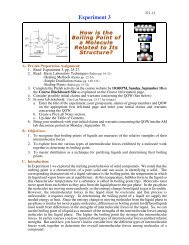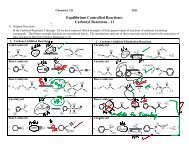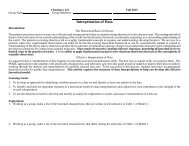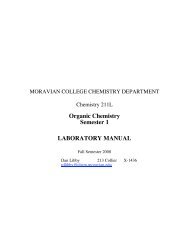D. Oxidation of Alcohols to Ketones 1. Introduction: In the previous ...
D. Oxidation of Alcohols to Ketones 1. Introduction: In the previous ...
D. Oxidation of Alcohols to Ketones 1. Introduction: In the previous ...
Create successful ePaper yourself
Turn your PDF publications into a flip-book with our unique Google optimized e-Paper software.
Chemistry 212-10<br />
Retrosyn<strong>the</strong>tic Analysis-3: Syn<strong>the</strong>sis <strong>of</strong> Ke<strong>to</strong>nes<br />
D. <strong>Oxidation</strong> <strong>of</strong> <strong>Alcohols</strong> <strong>to</strong> Ke<strong>to</strong>nes<br />
<strong>1.</strong> <strong><strong>In</strong>troduction</strong>:<br />
<strong>In</strong> <strong>the</strong> <strong>previous</strong> section we learned how <strong>to</strong> use C-C disconnections, FGI’s <strong>of</strong> Grignard reagents and FGI dehydrations <strong>to</strong><br />
syn<strong>the</strong>size larger alkenes and alcohols from smaller ke<strong>to</strong>nes or aldehydes and organic halides. This unit introduces methods<br />
for syn<strong>the</strong>sizing ke<strong>to</strong>nes from alcohols, ano<strong>the</strong>r FGI, since <strong>the</strong>se reactions change functional groups, but do not alter <strong>the</strong> carbon<br />
structure <strong>of</strong> <strong>the</strong> reactant. The addition <strong>of</strong> this reaction <strong>to</strong> our syn<strong>the</strong>tic reper<strong>to</strong>ire greatly increases our abilities <strong>to</strong> build larger<br />
molecules from a number <strong>of</strong> smaller molecules.<br />
2. <strong>Oxidation</strong> <strong>of</strong> 2˚ <strong>Alcohols</strong> <strong>to</strong> Ke<strong>to</strong>nes:<br />
Chromium Trioxide (CrO 3 ) in acidic aqueous solution (H 2 SO 4 ) is a common reagent for oxidation <strong>of</strong> alcohols. This metal<br />
oxide reagent is a relatively strong oxidizing reagent. It smoothly converts 2˚ alcohols <strong>to</strong> ke<strong>to</strong>nes.<br />
HO<br />
O<br />
H<br />
+<br />
CrO 3<br />
H 2 SO 4<br />
H<br />
OH<br />
+<br />
CrO 3<br />
H 2 SO 4<br />
O<br />
3. FGI-oxidation:<br />
The following FGI Retrosyn<strong>the</strong>tic step indicates that <strong>the</strong> ke<strong>to</strong>ne can be syn<strong>the</strong>sized from <strong>the</strong> corresponding alcohol by<br />
oxidation.<br />
O<br />
FGI<br />
H<br />
OH<br />
oxidation
Retrosyn<strong>the</strong>tic Analysis-2: Syn<strong>the</strong>sis <strong>of</strong> Ke<strong>to</strong>nes 2<br />
Although this is a simple addition <strong>to</strong> our reagent list, this oxidation increases our abilities <strong>to</strong> syn<strong>the</strong>size complex molecules from<br />
relatively simple ones. Consider <strong>the</strong> potential syn<strong>the</strong>sis <strong>of</strong> <strong>the</strong> complex molecule shown below. One Grignard C-C disconnection<br />
reveals that <strong>the</strong> target molecule can be syn<strong>the</strong>sized from phenyl magnesium chloride and 2,5-dimethyl-4-heptanone.<br />
H<br />
O<br />
C-C disconnection<br />
Grignard<br />
O<br />
+<br />
Mg<br />
Cl<br />
With only <strong>the</strong> Grignard C-C disconnection, we were able <strong>to</strong> disconnect <strong>the</strong> carbon structure <strong>of</strong> an alcohol only once.<br />
However, we now see that <strong>the</strong> ke<strong>to</strong>ne precursor revealed by <strong>the</strong> above disconnection can be syn<strong>the</strong>sized from a 2˚ alcohol as<br />
indicated on page 80 and reproduced below:<br />
O<br />
FGI<br />
H<br />
OH<br />
oxidation<br />
This FGI reveals a compound that can be fur<strong>the</strong>r disconnected with a Grignard C-C <strong>to</strong> reveal even simpler syn<strong>the</strong>tic<br />
precursors.<br />
H<br />
OH<br />
C-C disconnection<br />
Grignard<br />
H<br />
O<br />
+<br />
Mg<br />
Br
Retrosyn<strong>the</strong>tic Analysis-2: Syn<strong>the</strong>sis <strong>of</strong> Ke<strong>to</strong>nes 2<br />
If we recall that Grignard Reagents can be syn<strong>the</strong>sized from alkyl halides, we can look at <strong>the</strong> entire syn<strong>the</strong>tic pathway as a set<br />
<strong>of</strong> disconnections and FGI's. The starting materials are enclosed in rectangles.<br />
H<br />
O<br />
C-C disconnection<br />
Grignard<br />
O<br />
FGI<br />
<strong>Oxidation</strong><br />
+<br />
Mg Cl<br />
FGI<br />
Grig<br />
O<br />
H<br />
+<br />
C-C disconnection<br />
Grignard<br />
H<br />
OH<br />
Cl<br />
+ Mg o<br />
Mg<br />
Br<br />
FGI<br />
Grig<br />
Br<br />
+ Mg o
Retrosyn<strong>the</strong>tic Analysis-2: Syn<strong>the</strong>sis <strong>of</strong> Ke<strong>to</strong>nes 2<br />
4. Out <strong>of</strong> Class Application:<br />
For our next lab discussion period use retrosyn<strong>the</strong>tic analysis <strong>to</strong> devise syn<strong>the</strong>ses for <strong>the</strong> following compounds from<br />
monosubstituted aromatic compounds and non-aromatic compounds with four or fewer carbon a<strong>to</strong>ms.<br />
OH<br />
O<br />
Then write complete syn<strong>the</strong>tic paths, including reagents and reaction conditions based on your retrosyn<strong>the</strong>tic analyses.<br />
Be prepared <strong>to</strong> discuss both <strong>the</strong> retroanalysis and <strong>the</strong> syn<strong>the</strong>sis.


